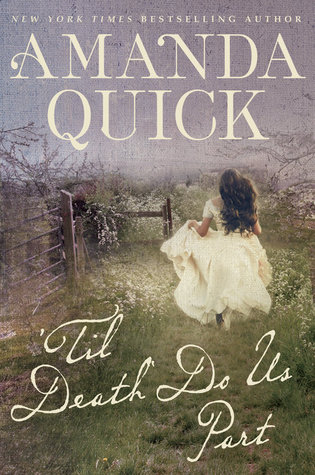 'Til Death Do Us Part by Amanda Quick
'Til Death Do Us Part by Amanda Quick Formats available: hardcover, ebook, audiobook
Pages: 352
Published by Berkley on April 19th 2016
Purchasing Info: Author's Website, Publisher's Website, Amazon, Barnes & Noble, Kobo, Bookshop.org
Goodreads
The author of the New York Times bestseller Garden of Lies returns to Victorian London in an all-new novel of deadly obsession. Calista Langley operates an exclusive “introduction” agency in Victorian London, catering to respectable ladies and gentlemen who find themselves alone in the world. But now, a dangerously obsessed individual has begun sending her trinkets and gifts suitable only for those in deepest mourning—a black mirror, a funeral wreath, a ring set with black jet stone. Each is engraved with her initials. Desperate for help and fearing that the police will be of no assistance, Calista turns to Trent Hastings, a reclusive author of popular crime novels. Believing that Calista may be taking advantage of his lonely sister, who has become one of her clients, Trent doesn’t trust her. Scarred by his past, he’s learned to keep his emotions at bay, even as an instant attraction threatens his resolve. But as Trent and Calista comb through files of rejected clients in hopes of identifying her tormentor, it becomes clear that the danger may be coming from Calista’s own secret past—and that only her death will satisfy the stalker...
My Review:
This is a stand alone Amanda Quick title, and I don’t think there’s been one of those in forever. So if you are looking for a way to get into her work, or if you’ve read her as either Jayne Ann Krentz or Jayne Castle and want to find out if she’s just as good doing historical (she is!) this is a great place to start.
‘Til Death Do Us Part starts out with a very creepy Gothic feel to it, and the suspense continues to build, even though it doesn’t follow all the traditional Gothic patterns. The hero is just as brooding and scarred as in any Gothic, but the heroine, righteously frightened as she is, still participates fully and effectively in her own rescue.
The story both exploits the Gothic tropes and turns them on their pointy little heads. And the story incorporates all the chills and spookiness of her Arcane Society series, without tripping over into the paranormal, just in case that’s not your cuppa.
While mediums and seances were a big fad during the Victorian era, and they are exploited in this story, everyone involved at least tacitly acknowledges that all of the so-called mediums are charlatans. Often very good charlatans, but fakes and frauds nonetheless.
Both our hero and heroine in this book are outside the norms for their society, but are emblematic of the types of characters that Quick employs to such terrific effect in her work.
Calista Langley operates what she calls an “introductions” agency. While many scurrilous rumors label it as a high-class brothel and her as the madam, that is far from the case. What she provides is a respectable location and atmosphere where properly vetted single women and single gentlemen can meet for an evening of intellectual stimulation and intelligent conversation. She, in the person of her brother, investigates every prospective “member” in advance, to make sure that they are exactly what they say they are – single, respectable and reasonable. Absolutely no fortune hunters get through her doors.
One left her nearly at the altar, and Calista is doing her best to provide other young women with options that she didn’t have.
Trent Hastings is a successful author of detective serials. (Think of him as a young and better looking Arthur Conan Doyle, without the “trip” to the fairies) But there is certainly a place inside Trent where he and his detective hero meet. Trent has also been truly heroic – he saved his sister from a dire fate by taking the acid meant for her on his face and body. The scars have made him a recluse, or so his family believes.
But Trent has done well for himself and his family, and the sister that he saved is now a “member” of Calista’s exclusive salons. In visiting Calista to ascertain whether or not she is taking advantage of his now well-to-do younger sibling, he finds himself attracted to the fiery Calista. And when he discovers that she needs help solving a mystery that is affecting her own life, he insists on offering his services as an investigator.
Calista needs the help, and desperately. Someone is sending her death tokens with her initials carved on them. The perpetrator has even managed to leave one in her bedroom, but no one is certain how he got there. Calista knows that she is being not merely followed, but stalked.
While someone is creeping around Calista behind the scenes, her former almost-fiance has let himself back in the front door, pursuing Calista and insisting that she feels something for him other than contempt. That he is married now, to the fortune he was hunting a year ago, does not seem to deter him from his pursuit of Calista. But the presence of Trent Hastings in her life certainly does.
Calista and Trent find themselves as unlikely partners in the chase for a cold, calculating killer who has been preying on young, lonely women for at least year. But when the hunter becomes the hunted, the chase leaves a wide trail of murder and destruction that leads straight to Calista’s door.
Escape Rating A: As is fairly obvious from the opening of the review, I loved this book. I kept picking it up at odd moments throughout the day, just to find out a little bit more about how they were doing, and what progress they were making in the hunt for the killer.
As far as the suspense angle in this case, there were plenty of very tasty red herrings, and I probably took a nibble at all of them. There were so many possible suspects, and all of them seemed more than plausible in one way or another. It was logical to look at Calista’s rejected club members, and it was equally logical to look at where all of the “memento mori” (death trinkets) were coming from. Trent and Calista brought different things to their partnership, and they worked together well.
I also enjoyed Trent and Calista as characters. They were both a bit anachronistic, but not so much as to trip the willing suspension of disbelief. After all, we know of someone who had a public career very like Trent’s in Arthur Conan Doyle. It was possible to create a best-selling private detective series and serialize in the papers. That everyone knows who Trent is and has an opinion on his story and characters feels quite plausible. After all, Conan Doyle got so sick of the attention to Holmes that he killed him off just to get the man out of his life.
Calista’s situation feels a bit more on the edge of just barely plausible. On that other hand, a woman on her own, raising her young brother, would have had to have found a unique way to make a respectable living – careers for women were non-existent in the 19th century. And Calista’s life history gives her insight into the pattern of the serial killer by providing her with empathy about the victims. She knows what it is like to be alone and vulnerable, with no family and friends to protect her and support her even in the emotional sense. The lonely and forgotten can be easy prey for someone who shows them a scrap of affection and regard.
The thing that fascinated me about the suspense angle was the serial killer. Jack the Ripper can’t possibly have been the first serial killer. He was just “lucky” enough to begin his career at the dawn of mass media and instant communication. But before there was any real psychological study of human beings, how would one go about determining that the murderer being chased had done it before and would do it over and over again because that was their modus operandi? Putting together the bizarre pieces of this case is good scary fun for the reader.
And there’s a romance. Trent and Calista stumble into each other’s lives. Neither of them believes that love and marriage is for them. Trent simply fears that no woman will be able to look past his scars. Calista has been forced to become an economically independent woman, and has discovered that she likes it. Marriage for her means giving up her freedom, and having little to no recourse if she chooses badly, as she very nearly did. Trent needs to make her believe that he not only loves her, but that he loves and respects her for who she truly it, and not for the role she might fill in his life.
Watching them overcome their skepticism leads to a lovely happy ending for all.






















